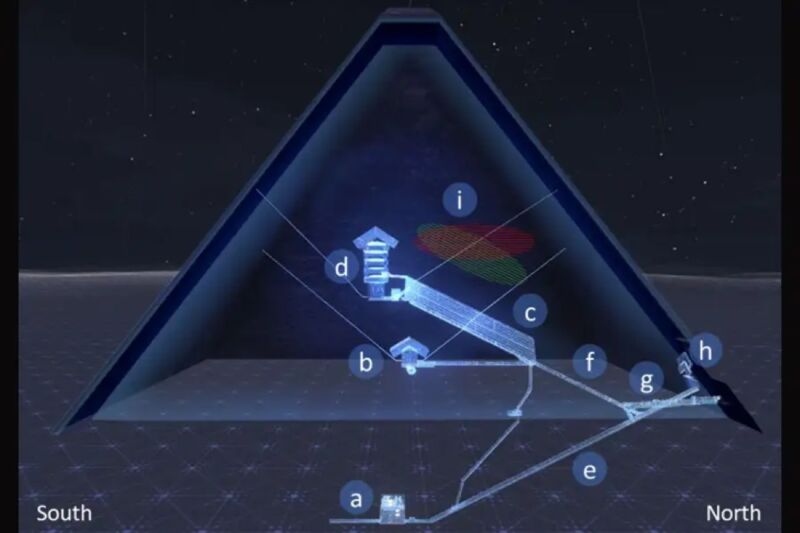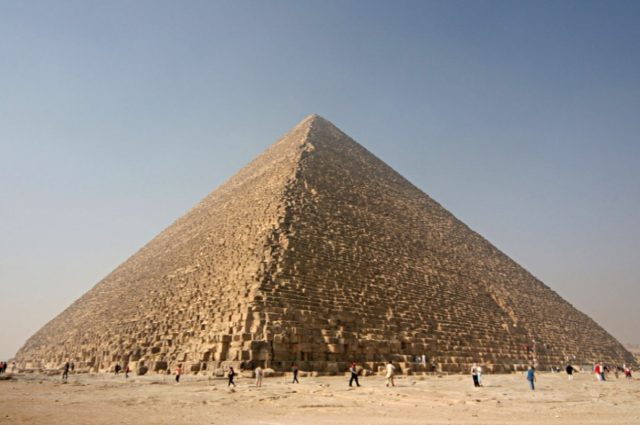Scientists have mapped a secret hidden corridor in Great Pyramid of Giza
[ad_1]

Procureur et al., 2023
In 2016, scientists using muon imaging picked up signals indicating a hidden corridor behind the famous chevron blocks on the north face of the Great Pyramid of Giza in Egypt. The following year, the same team detected a mysterious void in another area of the pyramid, believing it could be a hidden chamber. Two independent teams of researchers, using two different muon imaging methods, have now successfully mapped out the corridor for the first time, according to a new paper published in the journal Nature Communications. Zahi Hawass, Egypt’s former antiquities minister, called it “the most important discovery of the 21st century.”
As we’ve reported previously, there is a long history of using muons to image archaeological structures, a process made easier because cosmic rays provide a steady supply of these particles. An engineer named E.P. George used them to make measurements of an Australian tunnel in the 1950s. But Nobel-prize-winning physicist Luis Alvarez really put muon imaging on the map when he teamed up with Egyptian archaeologists to use the technique to search for hidden chambers in the Pyramid of Khafre at Giza. Although it worked in principle, they didn’t find any hidden chambers.
There are many variations of muon imaging, but they all typically involve gas-filled chambers. As muons zip through the gas, they collide with the gas particles and emit a telltale flash of light, which is recorded by the detector so scientists can calculate the particle’s energy and trajectory. It’s similar to X-ray imaging or ground-penetrating radar, except with naturally occurring high-energy muons rather than X-rays or radio waves. That higher energy makes it possible to image thick, dense substances like the stones used to build pyramids. The denser the imaged object, the more muons are blocked, casting a telltale shadow. Hidden chambers in a pyramid would show up in the final image because they blocked fewer particles.
Muons are being used to hunt for illegally transported nuclear materials at border crossings and to monitor active volcanoes in hopes of detecting when they might erupt. In 2008, scientists at the University of Texas, Austin, tried to follow in Alvarez’s footsteps, repurposing old muon detectors to search for possible hidden Mayan ruins in Belize. And physicists at Los Alamos National Laboratory have been developing portable versions of muon imaging systems to unlock the construction secrets of the soaring dome (Il Duomo) atop the Cathedral of St. Mary of the Flower in Florence, Italy, designed by Filippo Brunelleschi in the early 15th century. The dome has been plagued by cracks for centuries, and muon imaging could help preservationists figure out how to fix it.

As Annalee Newitz wrote for Ars in 2017, the Pharaoh Khufu (2509-2483 BCE) ordered the Great Pyramid to be built at Giza roughly 4,500 years ago. The structure remained sealed until 820 CE, when the Caliph al-Ma’mun broke open one of its walls and discovered three chambers inside, arranged vertically: the King’s Chamber, the Queen’s Chamber, and an abandoned subterranean chamber, connected by the “Grand Gallery,” a large corridor. There is also a descending corridor, an ascending corridor, and a passage dug in the Middle Ages that now serves as a tourist’s entrance.
[ad_2]
Source link




